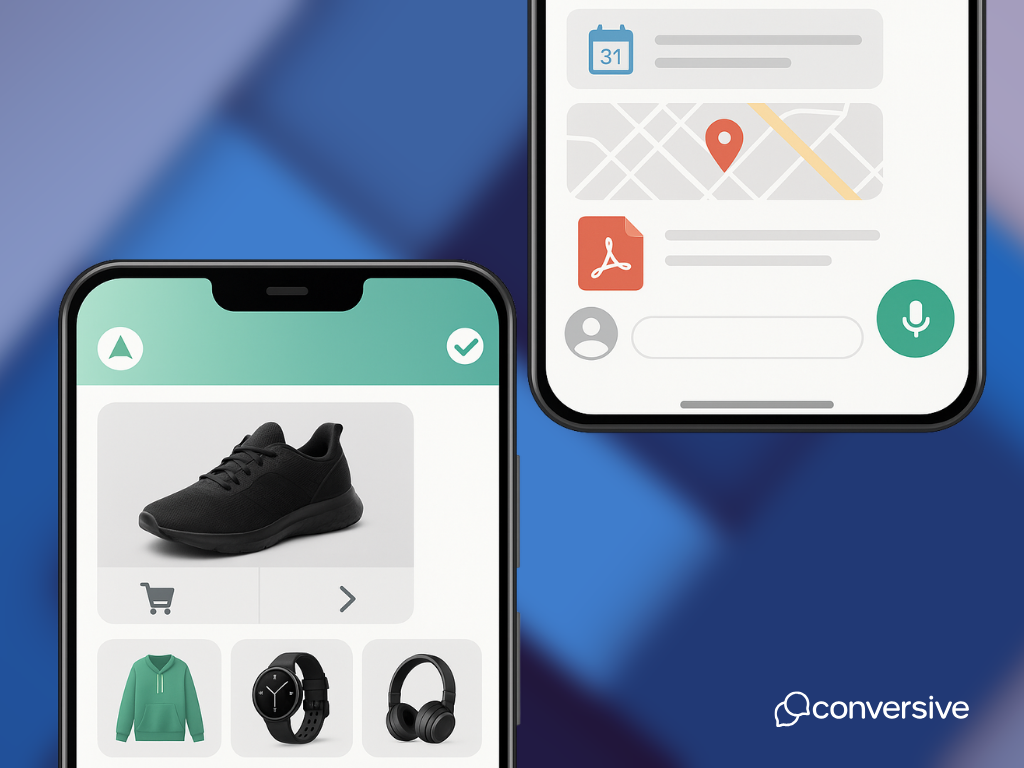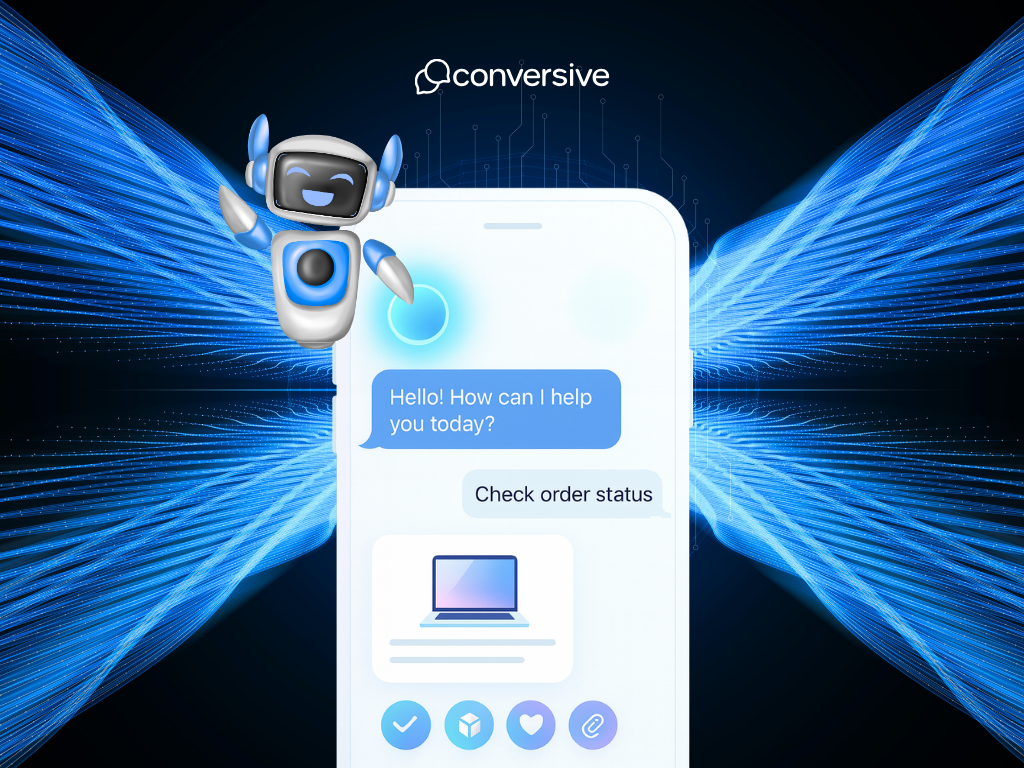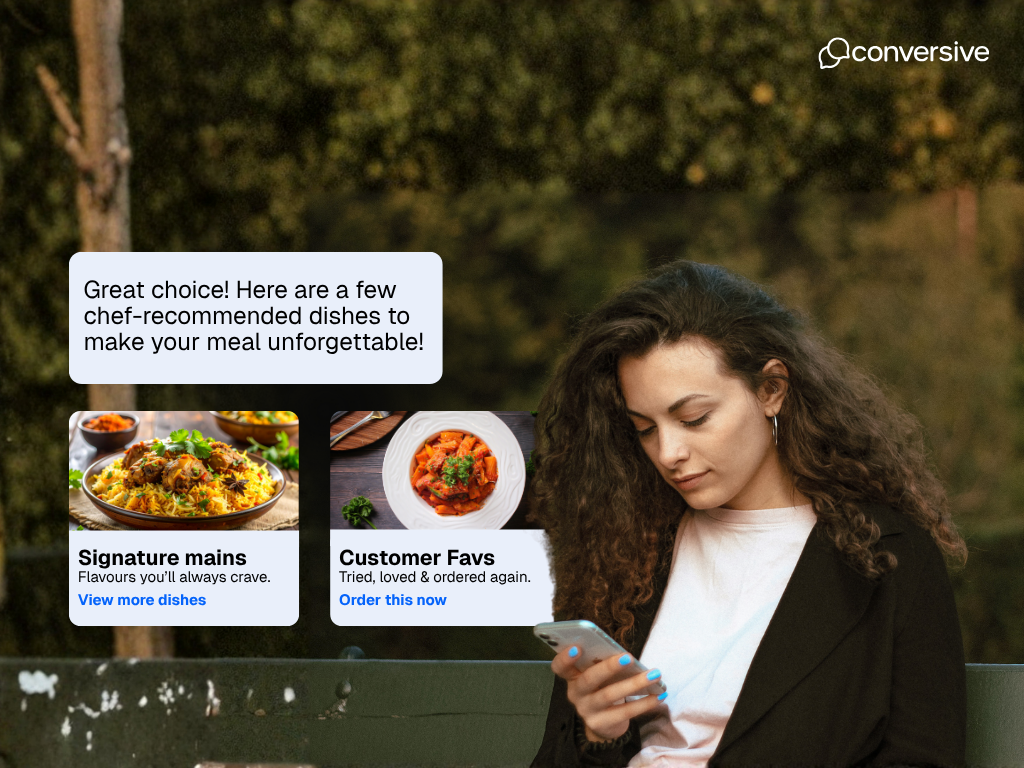
RCS vs WhatsApp: The Carrier-Led Comeback Marketers Shouldn’t Ignore
RCS is more than an SMS upgrade, it’s a carrier-backed, interactive messaging platform designed for verified business communication. Explore how it stacks up against WhatsApp and why marketers should pay attention.
WhatsApp is rapidly expanding its reach in the business-messaging space. Recent MEF surveys across 17 countries show that when companies contact consumers, messages are now more likely to arrive via WhatsApp than through traditional SMS.
This raises some obvious questions, like will the messaging infra of the future be controlled by closed ecosystems or remain an open carrier-managed utility. And surprisingly, carriers might not be as outgunned as everyone assumes.
RCS, The Long-Overdue Upgrade to SMS
Let's start with the basics first, RCS is the natural evolution of text messaging that mobile carriers have been developing for years.
It’s like saying, SMS is like sending a postcard, it gets the job done, but it’s limited. RCS, on the other hand, is more like sending a fully interactive digital message with images, buttons, read receipts, and everything built in.
RCS transforms your default messaging app that looks and feels like WhatsApp or iMessage. You get high-resolution photos and videos, read receipts, typing indicators, group chats to name a few all without downloading a separate app.
The technical term is “native experience”, with it, your phone's built-in messaging app just gets better. No new login. No friend-finding process. No installation. If someone has your phone number, you can send them rich messages, it's that simple and direct.
Now, if you see its impact on businesses, RCS lets companies do way more than SMS. For instance,
- A bank could send your full statement right inside the message.
- An airline might automatically add your boarding pass to your phone.
- A store could even show you a small list of products with simple “Buy Now” buttons.
Overall, it just makes business messages feel more like real apps instead of plain texts.
WhatsApp’s Dominance, and the Growing Need for RCS
To understand why RCS matters, we need to see how WhatsApp has disrupted the messaging ecosystem.
In many countries, WhatsApp didn’t just gain market share, it simply wiped out SMS revenues. As the internet became common everywhere, WhatsApp built a massive user base and became a serious revenue drain for carriers. And even though the global messaging market is still growing, most of that new growth is expected to go straight into WhatsApp’s pocket.
So this creates a bigger problem for carriers!
It’s not just about losing money on regular texting, which is small compared to the real money from business messages. The real prize has always been A2P (Application-to-Person) messaging, which is, messages businesses send to customers, things like,
- Banks sending fraud alerts
- Stores confirming purchases
- Airlines updating you about gate changes
This is the part of messaging where carriers actually make most of their profits.
Surveys show people get messages mostly in this order:
- SMS
RCS is way down at number 10. The gap between its potential and reality is huge.
RCS Has Advantages WhatsApp Can’t Replicate
Since WhatsApp has billions of users, does that mean it’s unbeatable?
Well, not necessarily. RCS still has some real advantages that aren’t obvious at first. Let’s discuss those:
1) The SIM Card Secret Weapon
RCS is intrinsically tied to the user's SIM card. So if the SIM is removed, RCS stops working. Now, this is a huge built-in feature.
For carriers, this creates a security moat that app-based messaging can't replicate. When you receive an RCS message claiming to be, let’s say, from a bank, there's a verification chain running through carrier infrastructure that confirms the sender's identity. The business ID literally cannot be spoofed if the system is working correctly.
Compare that to WhatsApp, where business verification exists but sits outside carrier control. For banking clients particularly concerned about fraud, the carrier-verified layer adds a dimension of trust that's genuinely valuable.
RCS also integrates Google Safe Browsing, which blocks malicious URLs before they're even sent. This means, any phishing or malicious link gets blocked automatically, keeping users and brands safe. For businesses worried about their brand being linked to fraud, this is very important.
2) The Persistence Advantage
RCS messages stay in your inbox permanently, just like SMS, they only go away if you delete them. Unlike app notifications, which disappear quickly, a promotional message from a retailer stays in RCS. For marketers, this is a huge opportunity, they can plan campaigns knowing messages will be there, thus, giving more chances for engagement even after the first send.
3) Trusted Branding That Actually Drives Results
When businesses send RCS messages, they can show their logo, brand colors, and verified name. This “trusted branding” might sound minor, but the impact is huge. 77% of consumers are more likely to engage with messages from brands they recognize.
4) The Apple Factor Changes Everything
Apple started rolling out RCS support about a year ago. With iOS 26, RCS became available on iPhones in several major markets. In the US market particularly, where iPhone market share hovers around 50%, this is a huge boost for RCS adoption.
This wasn't Apple being generous, it was Apple recognizing that cross-platform messaging needed to evolve beyond the “green bubble” problem.
The commitment from Google, Apple, and the GSMA (the mobile industry's standards body) provides carriers with the infrastructure to actually compete with OTT messaging. By expanding RCS beyond Android and turning it into a secure, cross-platform messaging solution, carriers now have a real opportunity to level the playing field.

How Businesses Are Actually Using RCS
Early RCS adoption focused on mid-funnel marketing, things like:
- Brand discovery: Helping consumers learn about a brand for the first time.
- Lead generation: Collecting potential customer information for follow-up.
- Sparking interest: Creating curiosity or engagement to keep users interested.
These campaigns looked impressive in demos but didn’t always deliver immediate ROI. That's changed, companies now have moved decisively toward lower-funnel activities, such as:
- Transactional traffic: Order confirmations, shipping updates, delivery notifications. The items that customers actually need and open immediately.
- Service-related campaigns: Post-purchase follow-ups, Net Promoter Score surveys, customer retention messages. The things that build long-term value.
- Authentication and verification: Two-factor authentication codes, login confirmations, identity verification. High-volume, high-value traffic.
This matters because it shows what RCS is really good at, not only marketing, but also being a reliable, useful tool for businesses to communicate with customers.
The Feature Set That Makes It Possible
Here are a few things, which users can you do with RCS but not with SMS:
- Rich Cards: Product showcases with images, descriptions, and up to four call-to-action buttons
- Carousels: Multiple products in a swipeable format, each with its own action button
- Calendar integration: Appointments, reminders, and events added directly to Google Calendar
- Maps integration: Store locators, directions, location-based services
- PDF attachments: Invoices, bills, receipts, statements
- Web view: Complex forms, checkout experiences, all without leaving the messaging window
- Audio files: Voice messages, podcasts, audio instructions
When you combine all these RCS features, the possibilities get really exciting. For example, a restaurant sends a Rich Card with this week’s special, a map to their location, and a reservation button that opens a booking page, all in one message. It’s like turning a simple text into a mini interactive experience for the user.
The ROI Reality Check
So, now the question that comes to our mind is, does RCS actually make money?
The answer is nuanced.
Marketers don't optimize for channel price, they optimize for ROI. A slightly more expensive message that drives 3x the conversions beats a cheap message that nobody acts on.
In certain use cases, RCS delivers better ROI than alternatives, including WhatsApp. The verified nature, persistence, and rich interactivity create conditions where engagement naturally runs higher.
But companies aren't abandoning other channels, the future is omnichannel. Brands support customers across:
- Meta's ecosystem (WhatsApp, Messenger)
- Google's ecosystem (RCS, Android Messages)
- Apple's ecosystem (iMessage for Business)
This also implies, RCS is additive, not replacement.
The data suggests RCS grows the overall A2P messaging pie rather than cannibalizing existing SMS traffic. To put simply, it’s creating fresh revenue rather than taking it from SMS.
What’s Standing Between RCS and Its Big Breakthrough
The above all sounds good, yet there are a few challenges that could prevent RCS from reaching its potential, such as:
1) The Pricing Trap
RCS pricing has traditionally been pegged to SMS pricing. In Brazil, for example, basic SMS runs about 5 cents, rich SMS about 7 cents. Meanwhile, WhatsApp charges less than 4 cents for transactional and authentication messages.
When trying to convince businesses to adopt a new channel, being more expensive than the established alternative is far from ideal.
Carriers argue that ROI matters more than price, and that’s not entirely wrong. But procurement teams at major brands look closely at cost per message, and when RCS is roughly 75% more expensive than WhatsApp for similar functionality, the conversation becomes difficult.
Some carriers are testing flexible pricing models, that is, different rates for transactional, marketing, and authentication messages. However, there’s still no industry-wide consensus, and consequently, fragmented pricing creates its own challenges.
2) The Device Fragmentation Nightmare
Not all devices support RCS the same way. Some phones have the latest RCS capabilities, like image carousels, buttons, and Rich Cards because they run newer software or have proper carrier support. Other phones may only support simple text features, or RCS may not work at all if the device, carrier, or software version doesn’t support it. So the experience can vary a lot from one phone to another.
The result is a “two-tier system” where the experience varies wildly depending on handset and carrier combination.
So if a brand is trying to launch an RCS campaign, it would need to know:
- Which devices support carousels?
- Which ones handle Rich Cards?
- What falls back to basic messaging if RCS isn't available?
The complexity is non-trivial.
This fragmentation problem is slowly improving, but slowly isn't fast enough when competing against WhatsApp's consistent experience across devices.
3) The Expertise Gap
RCS is still new for most businesses. Email marketing has been around for over 20 years, and even WhatsApp Business has clear guidelines and best practices. But RCS doesn’t have that expertise and specific knowledge to use it well.
Therefore, integration can be complex. Brands need to:
- connect to carrier MAP gateways
- navigate technical specifications
- understand message routing
- figure out verification processes
It's not plug-and-play.
Many companies lack internal RCS knowledge and struggle to find qualified partners. The ecosystem of agencies, consultants, and technology providers is still maturing.
4) The Spam and Fraud Threat
For RCS to work as a trusted channel, carriers have to keep it clean. One wave of fake or scam messages and people will stop trusting it instantly.
Verification helps, but it isn’t perfect. Carriers need:
- Strong checks for brands
- Tools to spot abuse
- Clear rules for how RCS can be used
- Fast action when someone breaks the rules
RCS is positioned as a carrier-managed service with strong controls to protect customers. That approach makes sense, but it only works if executed well. In the United States, the “big three” operators, which are AT&T, T-Mobile, and Verizon, along with UScellular, all support RCS, and many prepaid carriers and MVNOs have followed. With so many networks involved, keeping the experience clean, secure, and consistent becomes even more critical.
The Future of Customer Service Is AI, and RCS Is Built to Deliver It
RCS is actually in a great position for the AI boom in customer service. Customers today prefer real two-way conversations, over one-way messages. They want AI agents that can answer questions, solve problems, handle payments, and feel easy to interact with, and RCS makes all of this possible.
Companies can plug their AI systems and CRM tools directly into RCS, enabling customers to chat with an AI in a natural, back-and-forth way.
Use case: Let’s say you notice a suspicious charge on your bank account. Instead of calling support, you simply send a message. An AI agent can walk you through verifying the transaction, disputing it if needed, and even ordering a new card, everything handled right inside the messaging app, securely and without any friction.
Since RCS supports rich, interactive messaging, it becomes an ideal place for businesses to deliver AI-powered experiences. And as AI gets more capable, RCS naturally becomes an even stronger channel for these smart, conversational interactions.
Yes, WhatsApp can do this too, but RCS has two big advantages:
- It’s carrier-verified: The sender’s identity is confirmed by the mobile network itself.
- It’s tied to the SIM: The phone number and device are securely linked, reducing spoofing and fraud.
That extra layer of trust makes a huge difference for sensitive tasks, especially for banks and financial services.

The Multi-Channel Playbook: Where RCS Can Actually Win
So what's the endgame? Where does messaging land in five years?
The broader vision is a unified messaging experience where everything lives in one place, the regular messaging app. Friends, family, and businesses all share the same inbox, with RCS quietly powering the rich, interactive, verified conversations behind the scenes.
Well, that is the vision, but reality will probably be a bit more complicated. We’re more likely to see a split landscape, with each channel owning a different role:
- WhatsApp: Personal chats, group conversations, and informal business messaging, especially in markets where it already leads.
- RCS: Formal business interactions, transactional updates, and anything that needs verified, carrier-level security.
- Email: Longer, detailed communication and anything that needs an archive or paper trail.
- Specialized apps: Niche tools built for specific workflows, often integrating with multiple messaging channels at once.
Instead of one winner, each channel will carve out its own space.
But here's what carriers must do for RCS to claim meaningful market share:
- Solve the pricing problem: RCS needs to be cost-competitive for high-volume transactional messaging, even if premium features command premium prices
- Simplify integration: Brands need turnkey solutions that handle technical complexity transparently
- Maintain trust fanatically: One major security breach could kill momentum for years
- Educate relentlessly: Most businesses still don't understand what RCS is or why it matters
- Partner strategically: Be it with Google, Apple, messaging platforms, or technology providers, carriers can't do it alone
RCS Doesn’t Need to Win the War, Just Own Its Space
This isn't about one platform destroying the other. It's about the messaging landscape becoming more sophisticated, with different tools serving different needs.
RCS isn't going to make WhatsApp disappear. WhatsApp has too much momentum, too many users, and frankly, too good of a product for consumer messaging.
But RCS doesn't need to kill WhatsApp to succeed. It needs to become the preferred channel for verified business communication, the place where companies send messages they need customers to trust and act on.
That's achievable because the technology works and Apple's participation removes another barrier. The economics can work too if carriers get pricing right. Plus, the security side of RCS actually holds up really well.
Build a Messaging Strategy That Works Across Every Channel
RCS, WhatsApp, SMS, and AI-powered experiences all have a role to play. Knowing when, and how, to use each is what separates high-performing brands from everyone else.
Schedule a free consultation and learn how to unify your customer messaging for maximum reach and ROI.
Frequently Asked Questions
What's the main difference between RCS and SMS?
RCS adds rich media (photos, videos), read receipts, typing indicators, group chats, and interactive elements like buttons and carousels to your default messaging app. SMS is limited to 160-character plain text. Think of RCS as SMS upgraded to compete with modern messaging apps.
Can I use RCS between iPhone and Android?
Yes! As of iOS 26, Apple has enabled RCS support on iPhones in major markets. This means iPhone and Android users can now exchange rich messages with each other, ending the “green bubble” limitation.
Is RCS more secure than WhatsApp for business messages?
RCS offers carrier-level verification tied to your SIM card, meaning business identities can't be spoofed within the carrier infrastructure. It also includes Google Safe Browsing to block malicious links. WhatsApp has its own verification system. Both are secure, but RCS's carrier-level integration provides an additional trust layer that some businesses (particularly banks) value highly.
Do I need to download an app to use RCS?
No. RCS works through your phone's default messaging app. If your carrier and device support it, the functionality just appears, no separate download or setup required.
Why haven't I heard more about RCS if it's so important?
RCS has faced slow adoption due to device fragmentation, carrier deployment timelines, and the lack of iPhone support until recently. It's been growing behind the scenes, but awareness is lower than established platforms. That's changing as deployment accelerates.
How much does RCS cost for businesses compared to SMS or WhatsApp?
Pricing varies by carrier and market, but RCS has traditionally been priced slightly higher than SMS (around 5-7 cents versus 3-5 cents), while WhatsApp can be cheaper for certain message types (under 4 cents). However, businesses often see better ROI from RCS due to higher engagement rates, making the per-message cost less relevant.
What happens if someone doesn't have RCS, does the message still go through?
Yes. RCS messages typically fall back to SMS or MMS if the recipient's device doesn't support RCS. The sender usually sees an indicator showing whether the message was delivered as RCS or SMS.
Can RCS handle customer service conversations with AI?
Absolutely. One of RCS's strengths is enabling businesses to connect AI agents and CRM platforms for natural, bidirectional conversations. The rich interface supports interactive elements that make automated conversations feel more human and effective.




